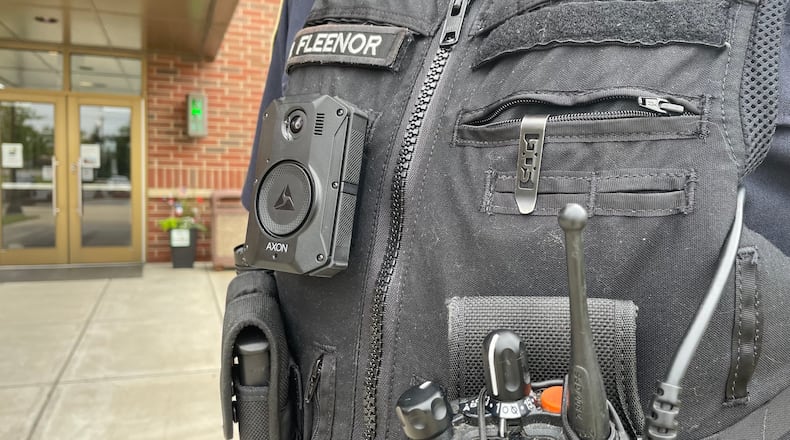DeWine’s office indicated 44 agencies statewide will use funding to create new body-worn camera programs and 68 will dedicate funding toward expanding or upgrading existing technology. Jones and Middletown Police Chief David Birk wanted to start new programs.
“Body cameras are an essential tool for policing, and the funds we’re awarding today will help agencies purchase around 1,660 new body cameras and associated technology,” DeWine said. “Body cameras are important not only for providing transparency to the public but also for adding an extra layer of protection for our officers.”
The sheriff was asking for $280,089 and received the second highest award statewide at $168,053 — Springfield Twp. in Hamilton County culled $244,838 — for the new program that would pay for about 150 cameras and start-up costs for the program. Jones applied for the grant in the first round too but was unsuccessful. He told the Journal-News previously he would have to hire two employees to maintain the data and handle the program.
Chief Deputy Anthony Dwyer told the Journal-News since they just received the grant they haven’t had time to determine what they’ll do.
“Obviously we wrote it for what is needed and it’s less, so we’ll have to take that amount and see how it applies to our agency,” Dwyer said. “I think we wrote for core services and other people that were in enforcement, so maybe we’ll have to scale it back a little bit, maybe we’ll look at our budget and fund it with other money, we haven’t made those decisions.”
He said they will talk to other agencies who have programs — they already have policies in place — to find out best practices and preferred equipment. As for hiring two employees, “we need to make an assessment, we have a diminished amount which means a diminished level of what we’ll be doing, the devil’s in the details.”
Middletown applied for $185,161 in the first round for 78 cameras, software and one records redaction specialist. This time Police Chief David Birk requested $124,218 and received $49,608. He told the Journal-News he is ecstatic to receive any funds at all.
“That is awesome, that is huge,” Birk said. “It’s better than nothing, it’s a start. I would probably take the $49,000 and maybe look at starting the body cam program with just maybe the patrol officers that have more contact with everybody instead of the whole department.”
He said he has about 40 patrol officers out of 73 officers total on the force, including detectives, narcotics and school resource officers. Birk said he is a huge proponent of body cameras, but there is no money in his budget to outfit the whole department.
“That’s why we kept on searching for grants and other ways to pay for them,” Birk said. “I’m a big advocate for the body cameras; I think studies have shown that it exonerates the officers more times than it actually shows the officers doing wrongdoing. With all the cameras and phones out there it’s just another way to make sure we’re keeping the professionalism of law enforcement in the profession.”
Bret Crow, communications director for the Ohio Department of Public Safety, told the Journal-News previously the priority was to get cameras into the hands of agencies that don’t already have programs, however more existing programs received funds than new. With limited funds available — they received requests totaling $11.4 million for this round with only $5 million available — the Office Criminal Justice Services needed to maximize the impact.
“OCJS attempts to fund as many body-worn camera programs as it can,” Crow said. “As with the first round of grants, OCJS reviews many factors when awarding funding including supplying enough body-worn cameras to cover an agency’s largest shift of officers working at the same time.”
For years Butler County police departments shied away from body cameras because of the cost and the uncertainty about what needs to be retained as a record, what should or cannot be redacted and other privacy issues.
Birk said they were required to include a policy in their grant application — they already had a version of one for dash cams — and according to the policy officers must “activate the body worn camera to record on all calls-for-service and during any self-initiated law enforcement or investigative encounter.”
A new law took effect in 2019 that gave guidance for using the cameras, it identified 17 instances in which video recorded by body cameras are exempt from disclosure. Among them are:
• Inside a residence unless the incident involves “an adversarial encounter with, or a use of force by, a peace officer”
• Showing children
• A death or body, unless it was caused by a peace officer
• A nude body, unless the person consents
• “Grievous” bodily harm to a peace officer, firefighter, paramedic or other first responder
West Chester Twp. asked for and received $46,325. Police Chief Joel Herzog said it will cover a year of the new five-year service contract the township recently approved with Axon Enterprise, Inc. —the company outfitting most if not all of the police agencies here — that totals $231,841. The contract is all inclusive and they get all new hardware with the package.
Herzog said the governor’s program is good for everyone.
“I think this is a great idea moving forward, especially you know it’s to help agencies that have them to maintain them because the cost is expensive, for us .. over $45,000 a year for us,” Herzog said. “And to get these other agencies that couldn’t afford them before into having the transparency the public likes to see these days.”
Fairfield Twp. wanted $41,851 and received $18,965, so Police Chief Bob Chabali said they will likely use the cash for newer batteries.
“Those batteries wear out and that’s the highest priority right now,” he said, and that they could potentially buy some more cameras as they increase staff. Their program is 2 years old, and they started with 25 devices, but are authorized for 28 officers.
“We would buy enough to have spares when we reach 28,” Chabali said.
He said the cameras have been “incredibly” invaluable and pointed to the officer involved shooting last month as a prime example.
“They validate our officers actions when we have had complaints,” Chabali said. “It also has assisted in evidence for our officers when they go to court, it actually caught the shooting that we had on body cam which is instrumental for the investigators and the grand jury to look at. The officers actually want them because it protects from false accusations.”
Fairfield, Miami University, Monroe, New Miami, Oxford and West Chester Twp. have also had the technology for a while. Hamilton requested $386,920 and received $81,776 in the first round of funding this year to start their program. In that round six police agencies applied for a total of $931,859, Oxford received $31,451 of the $34,732 they requested and Oxford Twp. received their full $10,546 request.
West Chester did not get $34,410 it was seeking.
About the Author

